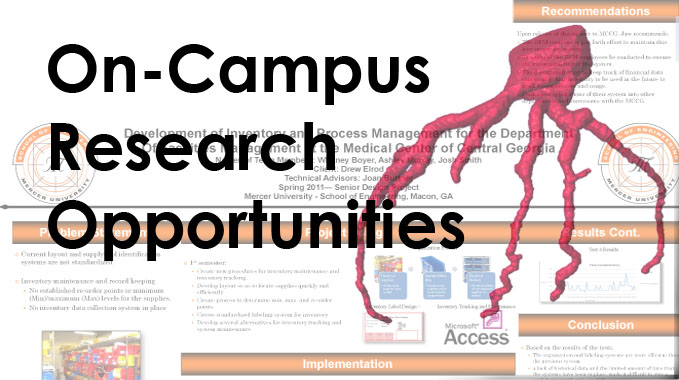
On Campus Research Opportunities
Application of Lean and Human Factors Principles to Process Improvement at Piedmont Healthcare
Project Description:
Piedmont Healthcare is implementing a program of process improvement in the emergency departments of its hospitals. Students are encouraged to participate on a number of potential projects. Students will be needed to serve on teams led by Piedmont personnel to analyze current processes, recommend changes, and implement and evaluate those changes. Potential areas for research include workload analysis, participation in lean events (events designed to streamline processes to eliminate waste and inefficiencies), ergonomic evaluation and design, and facilities design.
Minimum Requirements (technical/non-technical skills or prerequisite coursework): A variety of projects are anticipated and the necessary skills and coursework are varied. For most a basic understanding of engineering design is sufficient to start. Students will be required to pass a drug test and background check and will need to be able to travel to Piedmont Hospital in Atlanta to observe activities in the emergency room.
Time Commitment (hours per week): Variable depending on the specific project and student schedules.
Contact Information:
Name: Dr. Laura Moody
Department: Industrial Engineering and Industrial Management
Email: moody_le@mercer.edu
Project Active Until: TBD
Funding sources: At present this project is unfunded. Negotiations are underway to reimburse student travel expenses to Atlanta for observation and data collection.
Morphological Comparison between Healthy and Diseased Coronary Artery Systems using Medical Image Processing
Project Description:
Using medical image processing software, geometric information of coronary arteries for healthy, slightly stenosed, and severely stenosed will be measured. The correlations between morphological characteristics of coronary artery and severity of stenosis of coronary artery will be investigated. The correlation will be used the prediction of the onset and the development of arterial diseases such as atherosclerosis for a preventative medicine approach. There are about 100 patients’ CT images including healthy subjects, slightly stenosed, and severely stenosed coronary arteries. Using ScanIP (Simpleware Inc.) three-dimensional coronary arterial model will be created to measure geometric data of the arterial models. Morphologic characteristics of the coronary artery model will be evaluated statistically
Minimum Requirements (technical/non-technical skills or prerequisite coursework): Microsoft Excel, Word, and Powerpoint. High school Biology I and II. Anatomy is an extra. We will teach you how to use ScanIP software.
Time Commitment (hours per week): 5 hours per week. 2 freshmen will be expected for the project.
Contact Information:
Name: Dr. Dr. Sinjae Hyun
Department: Biomedical Engineering
Email: hyun_s@mercer.edu
Project Active Until: Current
Funding sources: At present this project is unfunded.
“The effect of developmental age on the excitability and cellular anatomy of midbrain dopaminergic neurons.”
Project Description:
Studies in humans show evidence for increased vulnerability to drug addiction during youth and adolescence. While this is likely to be due to a convergence of multiple factors, both human and animal brains undergo changes during development that may contribute to a greater risk of becoming addicted to drugs when exposed during critical periods. The brain’s natural reward system includes the dopamine-releasing neurons of the ventral midbrain, and it is these cells that are targeted by addictive drugs. All known addictive drugs increase the release of dopamine from these cells. The purpose of this study will be to examine how developmental age affects the intrinsic excitability of these addiction-related neurons (i.e., how likely they are to fire action potentials when excited, and thus release dopamine). In addition, developmentally regulated changes in cellular anatomy will also be explored and correlated with changes in intrinsic neuronal excitability.
The student will be trained in the preparation of both fresh and fixed brain slices harvested from mice at various developmental ages. Conventional patch-clamp electrophysiology will be used to examine the intrinsic excitability of dopaminergic neurons in the ventral midbrain. Immunohistochemical methods will also be used to selectively stain these cells. Fluorescence microscopy will be used to quantify developmentally regulated changes in cellular anatomy. Upon completion of these studies, results will be submitted for presentation at a national meeting, and eventually published in a peer-reviewed journal with joint authorship being available for the participating student.
Minimum Requirements (technical/non-technical skills or prerequisite coursework): There are no minimum requirements for this project, but a basic understanding of electricity and cellular neurophysiology would be beneficial.
Time Commitment (hours per week): 20 – 40 hours/week
Contact Information:
Name: Andon N. Placzek, Ph.D.
Department: Division of Basic Medical Sciences
Email: placzek_an@mercer.edu
Project Active Until: Ongoing
Funding sources: This is currently a volunteer position, but salaries/stipends may be available to those students who demonstrate exceptional commitment to the project.

